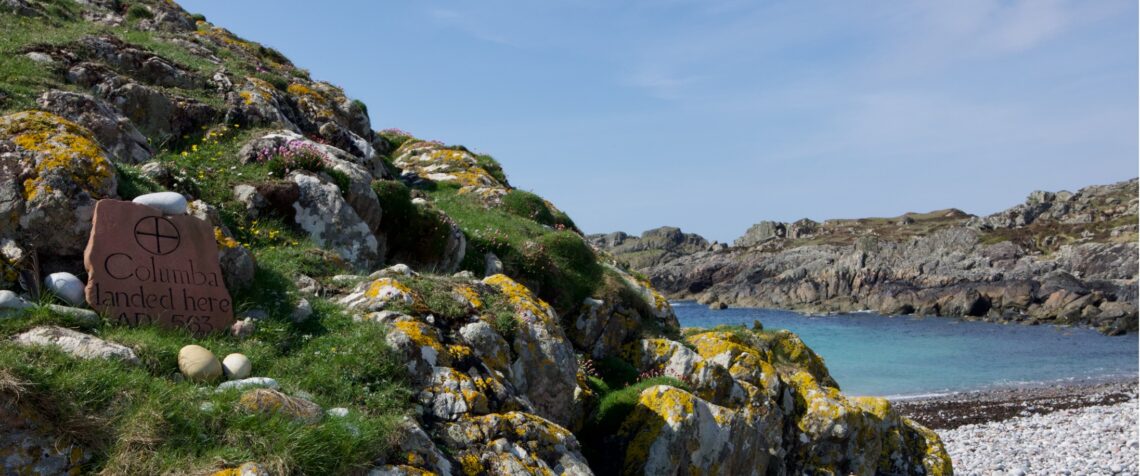
A walk to St Columba’s Bay
The beaches of Iona! I don’t think there are any words that do them justice. Sand so dazzling that you can feel the light being reflected up into your face. Pebbles that slip easily into your hand, wave-pounded and silky smooth. A sea so vividly turquoise that you have to stand and ask yourself if it’s real.
This is St Columba’s sacred isle, and when you wander around this gentle landscape of low grassy hills and flower-studded dunes you do truly feel as if you’re treading in the footsteps of the saints. Apart from the occasional tractor, all the sounds you can hear are natural ones: cuckoos calling, skylarks pouring out their airborne songs, the distant bubbling of curlews and oystercatchers. There are modern buildings, of course – people do live here – but scattered among them are old walls and cloisters and gardens where lives were spent in devotion: the Abbey, now restored, where St Columba lived, worked, and was buried; the warm pink stones of a 13th century nunnery; high crosses marking the age-old route of pilgrims.
At the southern end of Iona is St Columba’s Bay, the place where Columba and his twelve companions are said to have alighted from the curragh or coracle that had carried them across the sea from Ireland. Having climbed a nearby promontory to make sure that his beloved homeland was out of sight – a condition of his self-imposed exile – Columba buried his coracle on the beach and set about finding somewhere to establish a simple monastery.
The walk from Iona’s ferry terminal to St Columba’s Bay is quite a long one – at least two and a half miles – so if you want to spend a good amount of time there it’s tricky to do it in a day trip off the ferry. The best solution is to stay on Iona, which is what Colin and I did last week.
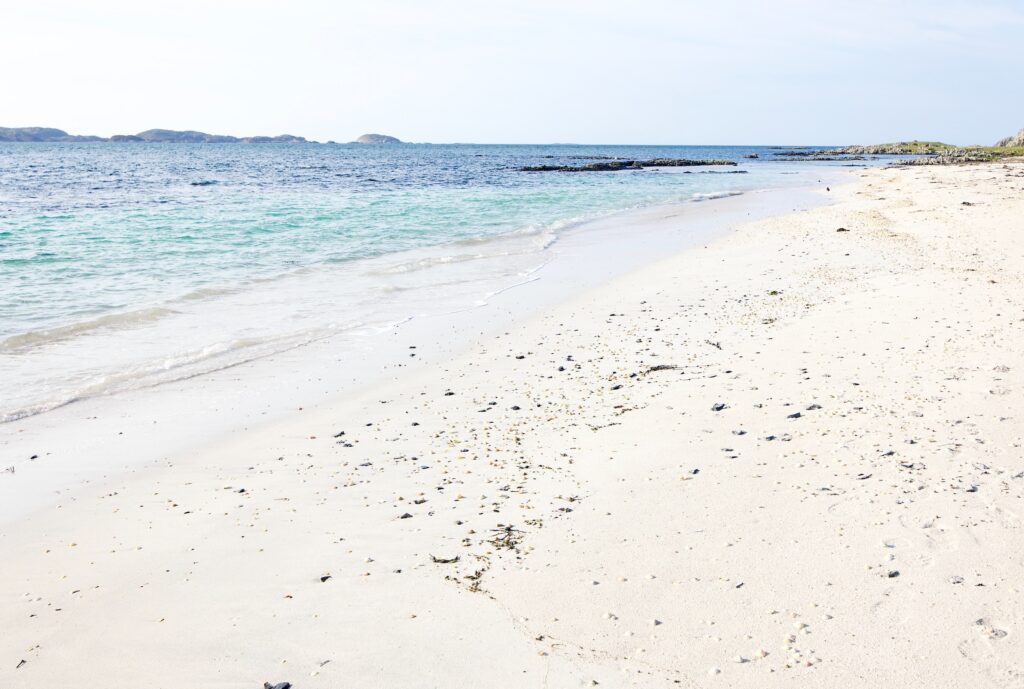
Martyrs’ Bay
Setting off just after 8 o’clock, under a clearing sky that promised later warmth, we walked through the island’s only village of Baile Mor, where the shops were still shut and few folks were stirring. We made a small diversion – because how could you not? – onto the freshly-washed sands of Martyrs’ Bay, and then turned west along the road that crosses the breadth of the island. It was here, on the edge of a sheep field, that we first heard the distinct sound of a corncrake.
Corncrakes, I believe, have a secret sense of humour. They give a good long croak, a bit like the rasping of wood on a washboard, and then they listen in the hope that you’re getting out your binoculars. They give you a good five minutes to scan the reedbeds in growing frustration and then, just as you’re picking up your bag to move on, they’ll let out another croak from a slightly different spot, which they can do just by moving their heads. It must give them hours of amusement. (I’ve got to say that, on a previous visit, we were extremely lucky to see a corncrake calling out in the open, standing in some fairly short grass. He probably knows better by now.)
Leaving the corncrake to a long and fulfilling day of entertainment, we pushed open the gate that leads across sand dunes to the Bay at the Back of the Ocean. This is one of Iona’s iconic beaches, and it draws you like a magnet. You can sit down anywhere at random and find all kinds of little pebbles and sea shells. Cowries are washed up here, and on the sand they seem to glow with a soft inner light.
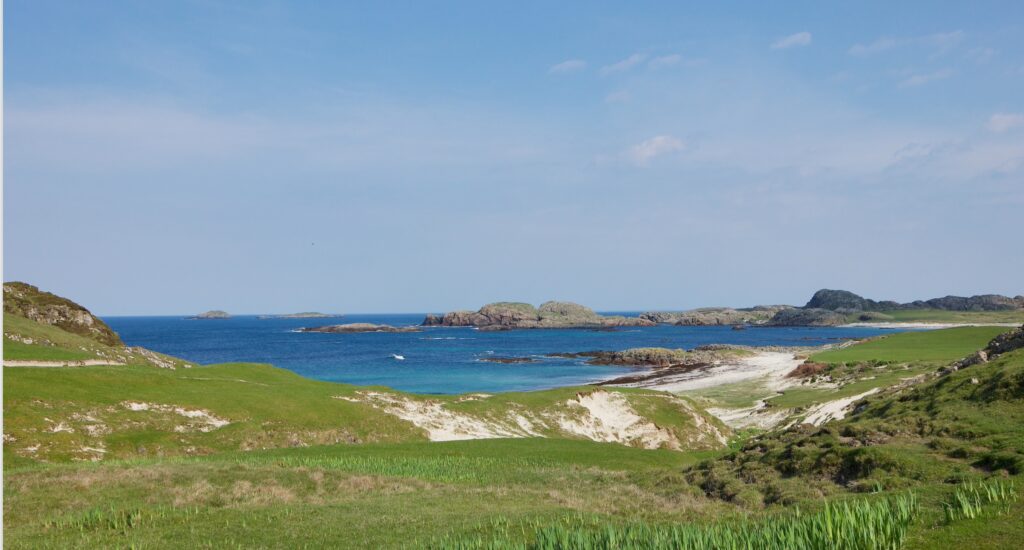
The Bay at the Back of the Ocean (above) and its treasures (below)
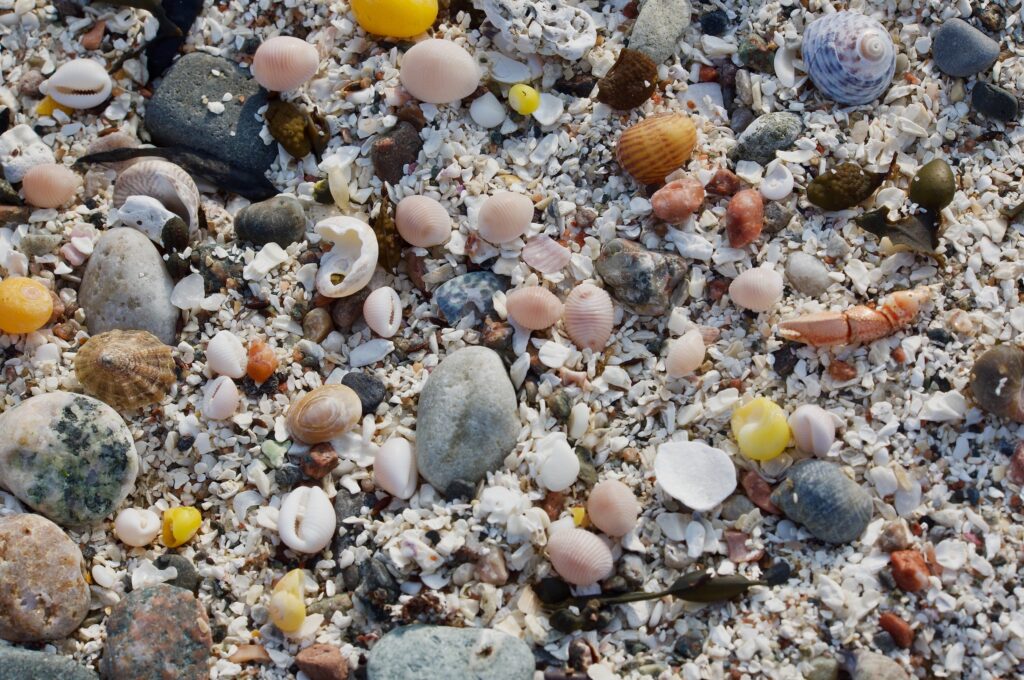
But we weren’t even halfway to St Columba’s Bay. The footpath led up over some low rocky hills, passing a lochan where some geese had settled, and then descending towards a distant sparkling sea. Was this the way that St Columba and his companions came, heading in the other direction, looking for a place of sanctuary? Did they struggle up the rocky pass and wonder if they’d been a bit premature in abandoning their boat? (‘Hey, Columba, we could have rowed right round to the other side! What d’you want to go and bury it for?’)
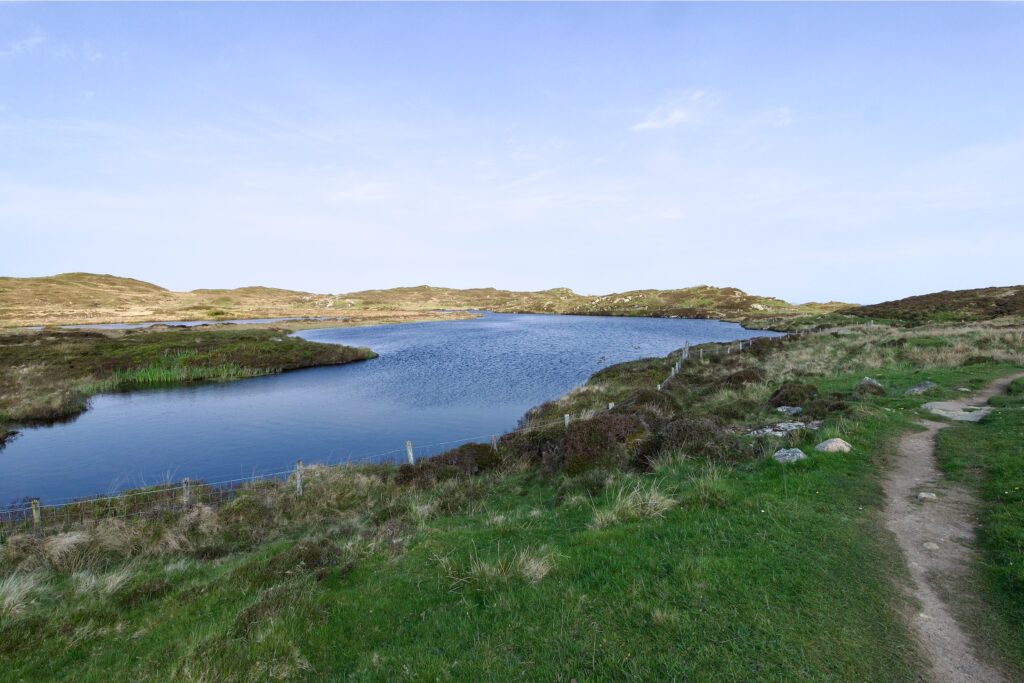
Loch Staoineig (above) with greylag (below)
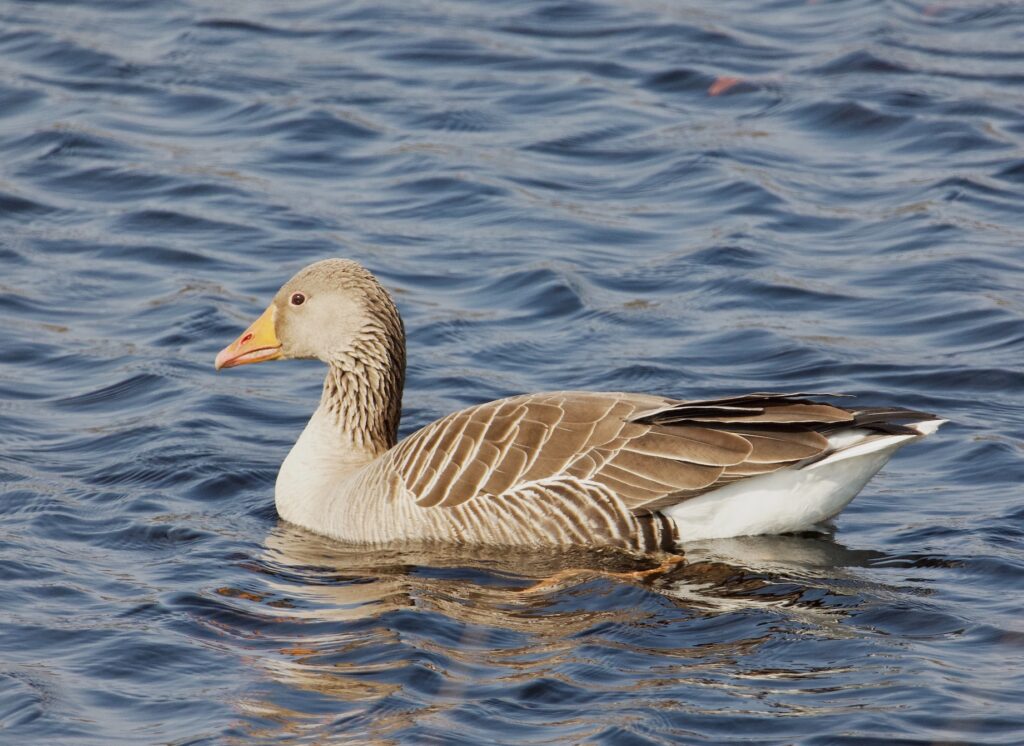
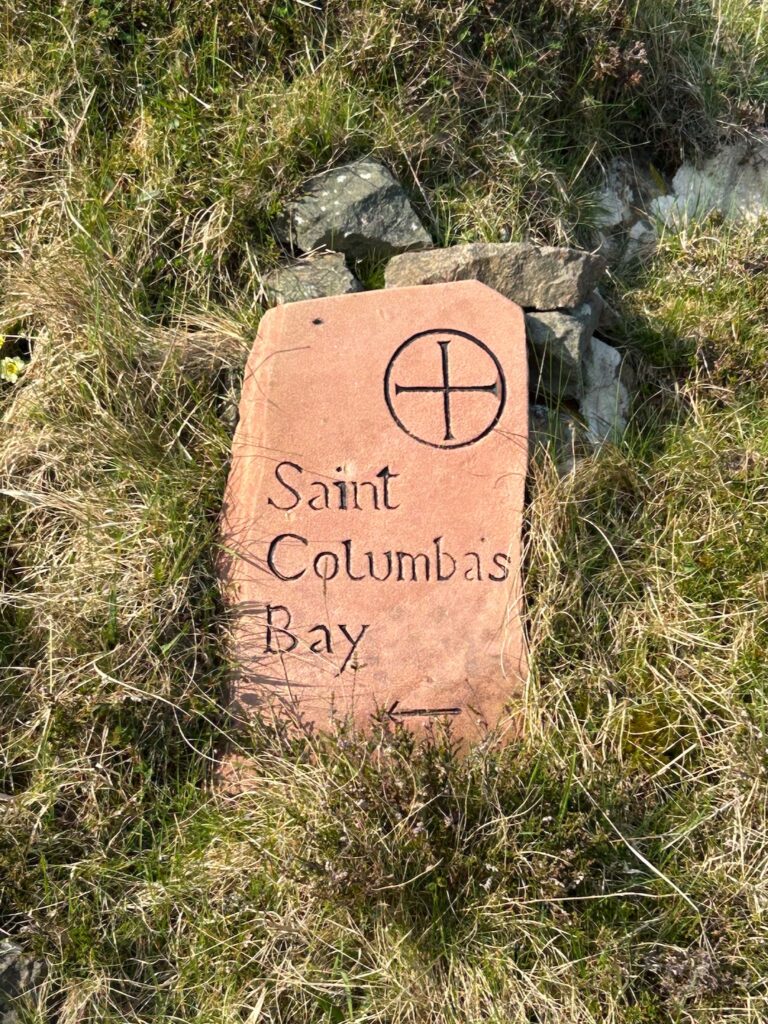
Waymarker
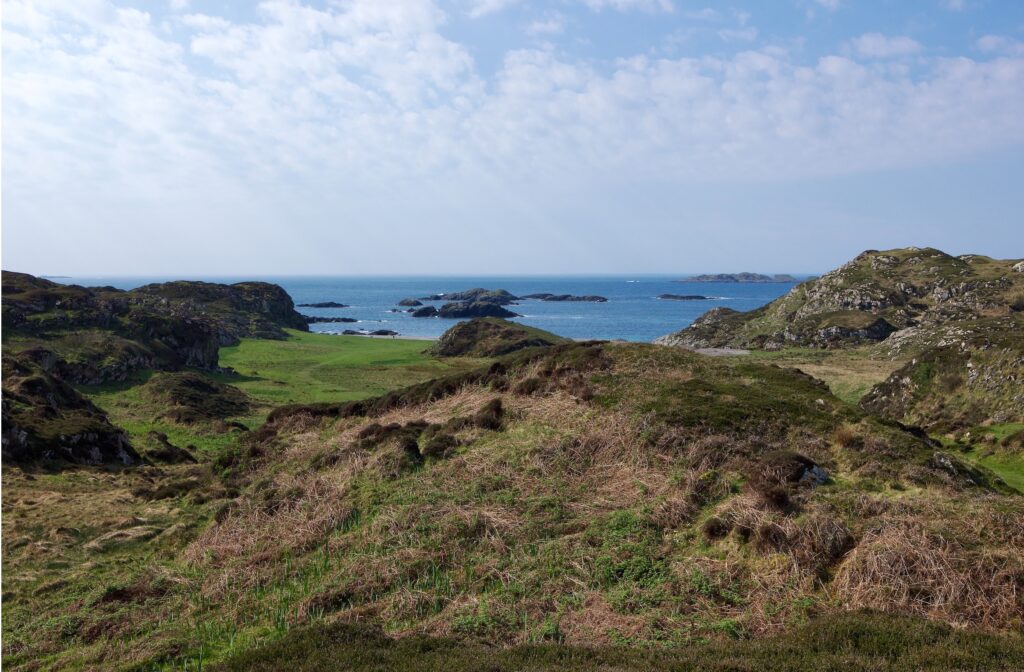
View from the pass towards St Columba’s Bay (above) and approaching over the grassy foreshore (below)
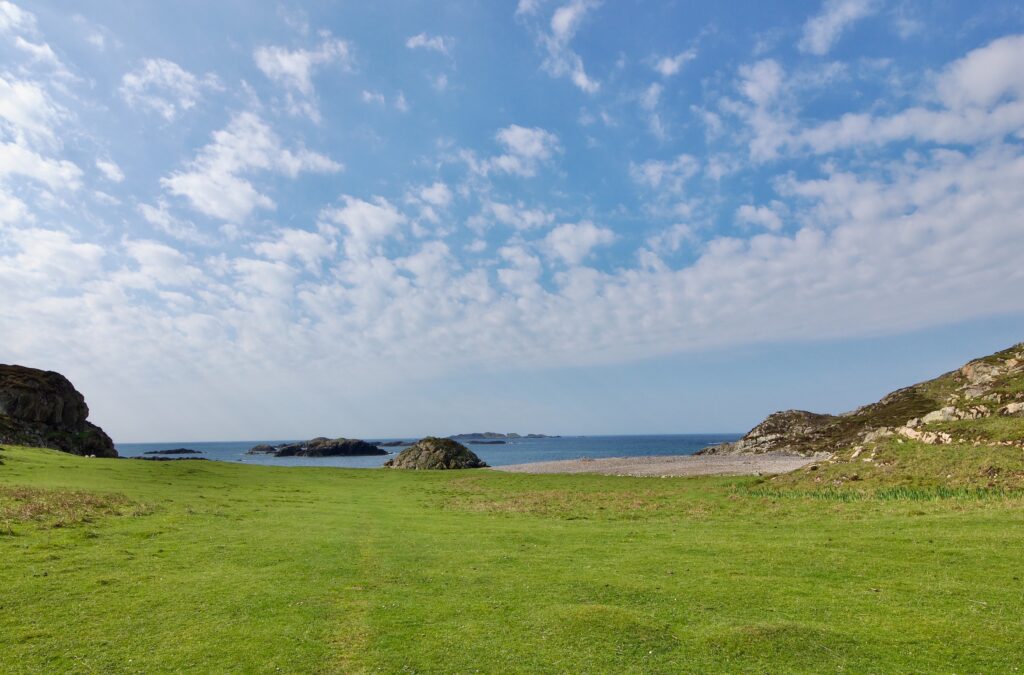
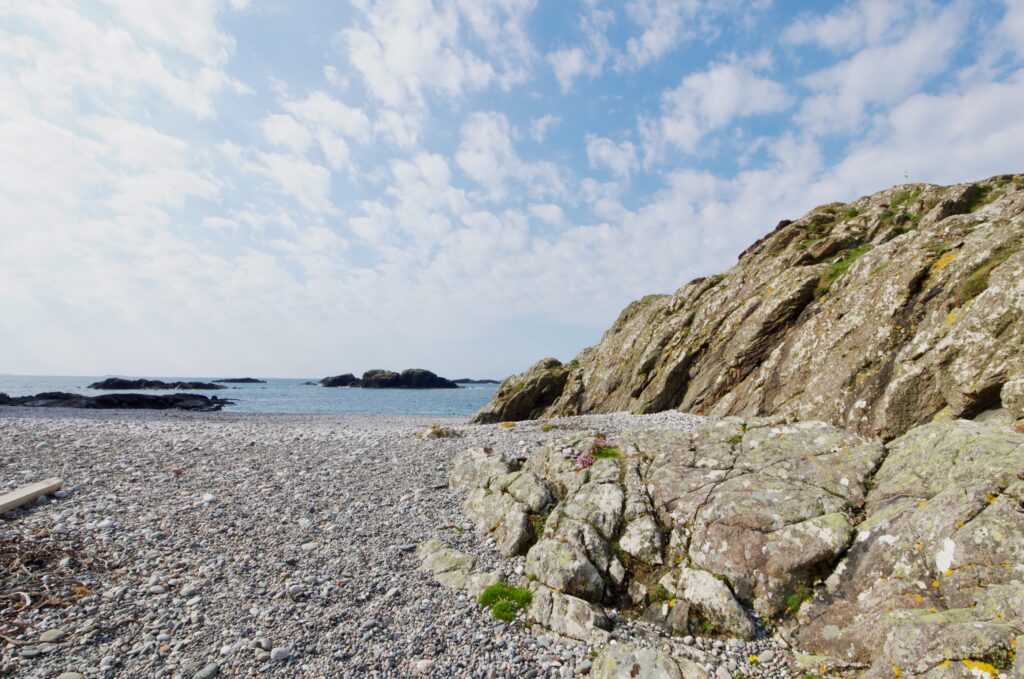
This was a different kind of beach, with a shoal of rocky islands just offshore. No sand here, only deep banks of pebbles that were drying in the sun as the tide retreated. Some were curiously lined and patterned, others sparkled with mica, and many more contained flecks and stripes in brilliant colours. You could sit here for hours – and we did – just picking up stones and putting them down again, while listening to the waves doing exactly the same, with that rhythmic tumbling sound of stones being swirled in water.
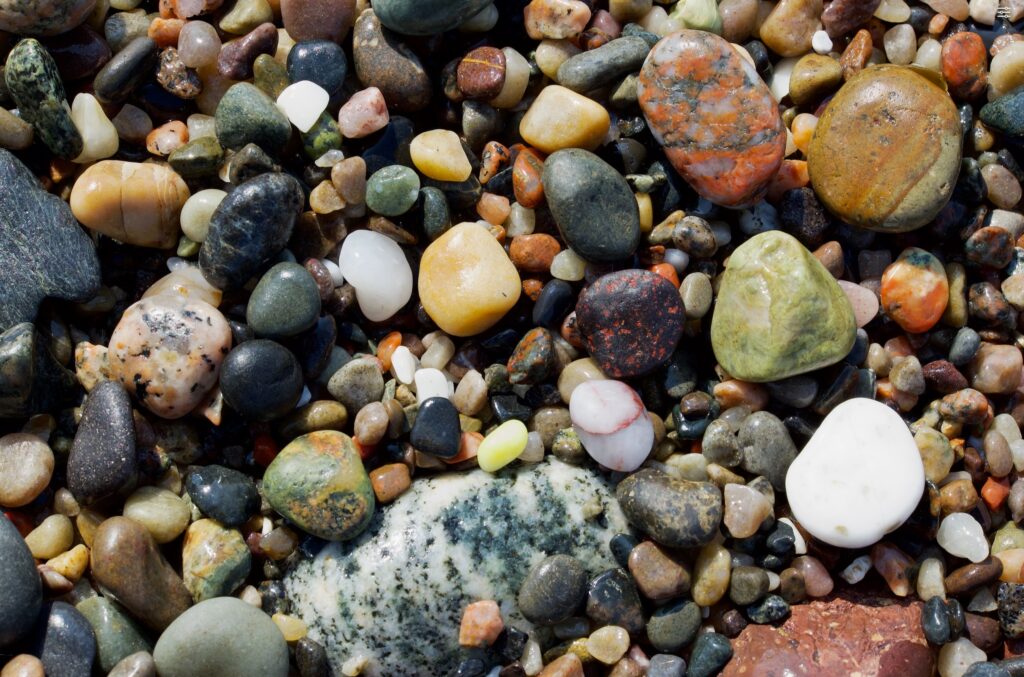 At St Columba’s Bay it’s said that you can find tiny translucent pebbles of green serpentine known as ‘St Columba’s tears’. There are probably one or two in this photo.
At St Columba’s Bay it’s said that you can find tiny translucent pebbles of green serpentine known as ‘St Columba’s tears’. There are probably one or two in this photo.
Colin went in search of wild flowers while I walked a labyrinth that has been made just above the high tide line. Then we both climbed to the top of a crag that divides the beach into two parts: on the left is Port na Curaich, the port (landing-place) of the coracle, and on the right is Port an Fhir-bhrèige, the interestingly-named ‘landing-place of the false man’. I’d love to know if there’s a story behind this name.
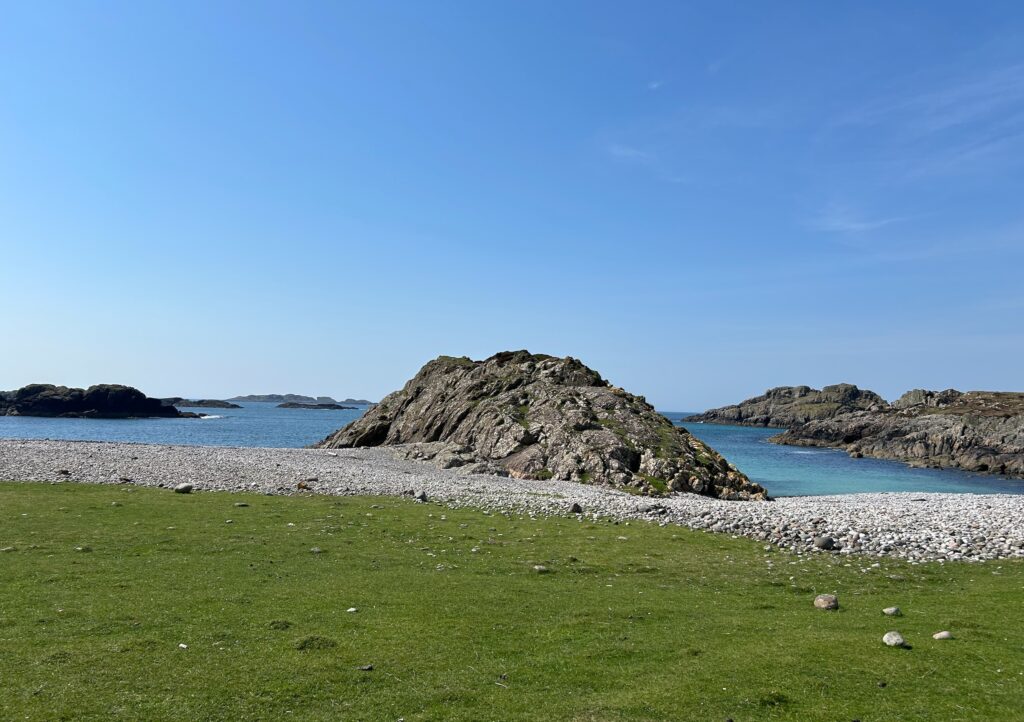

Port na Curaich (above) and Port an Fhir-bhrèige (below)
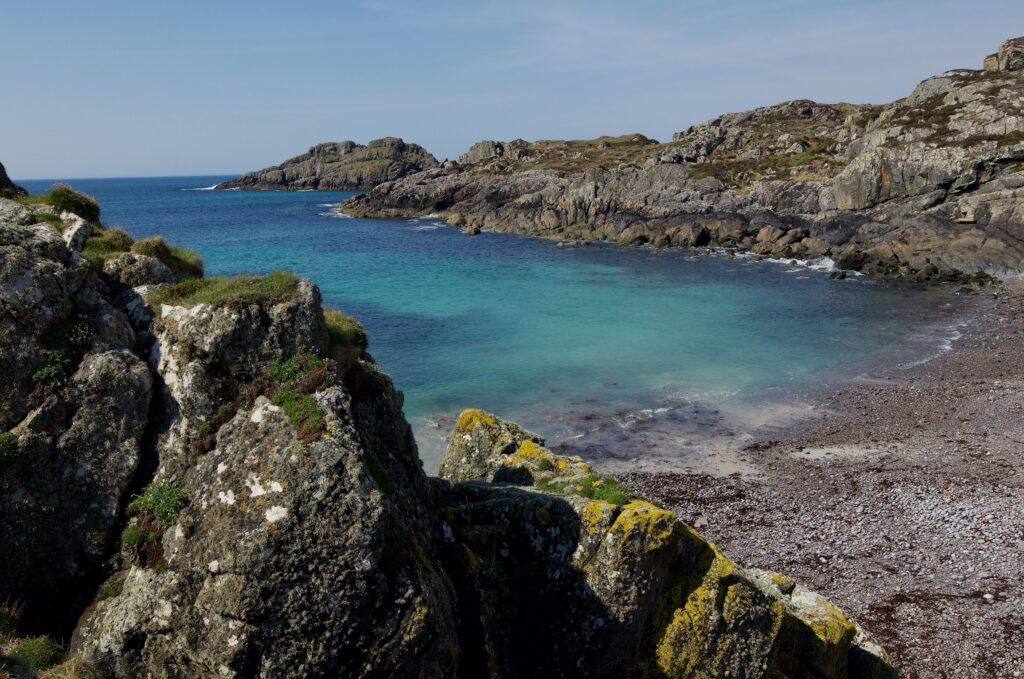
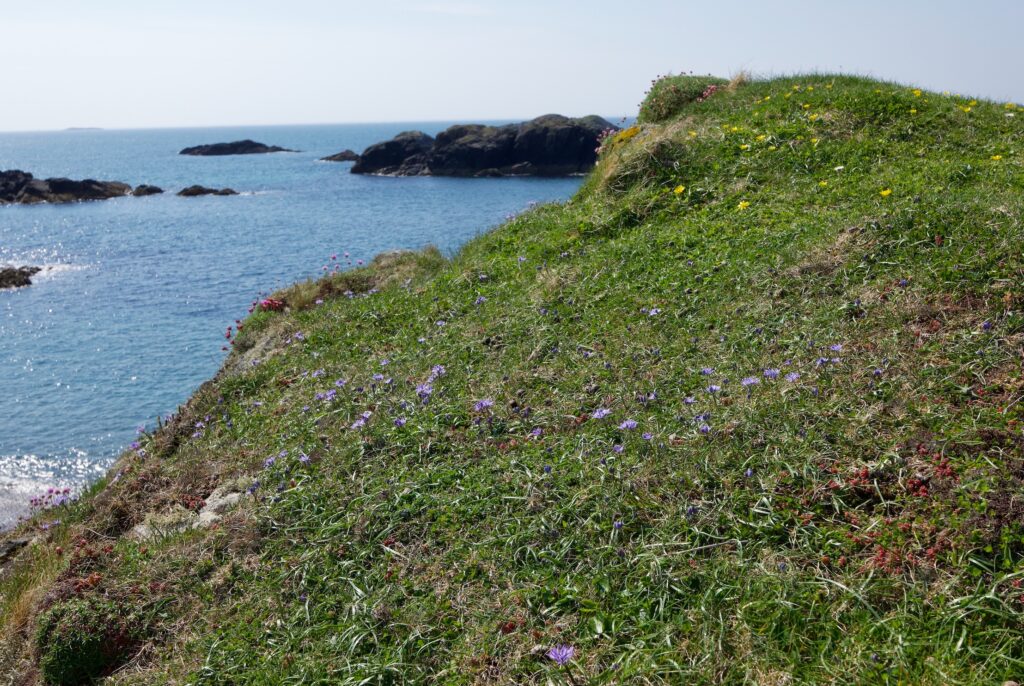
Spring squill (Scilla verna) growing on the crag
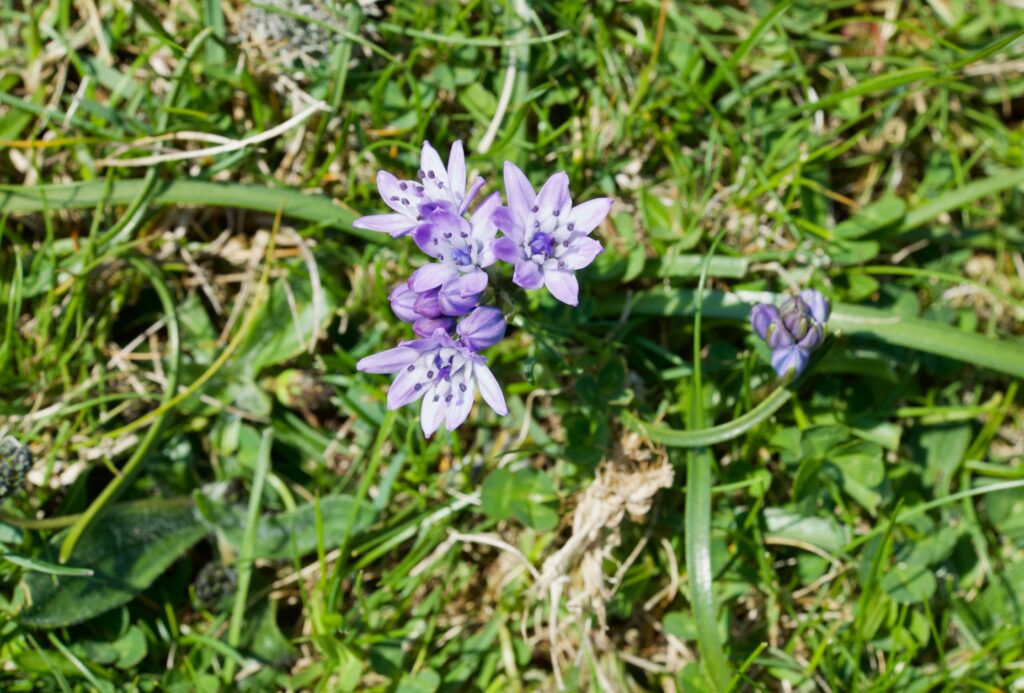
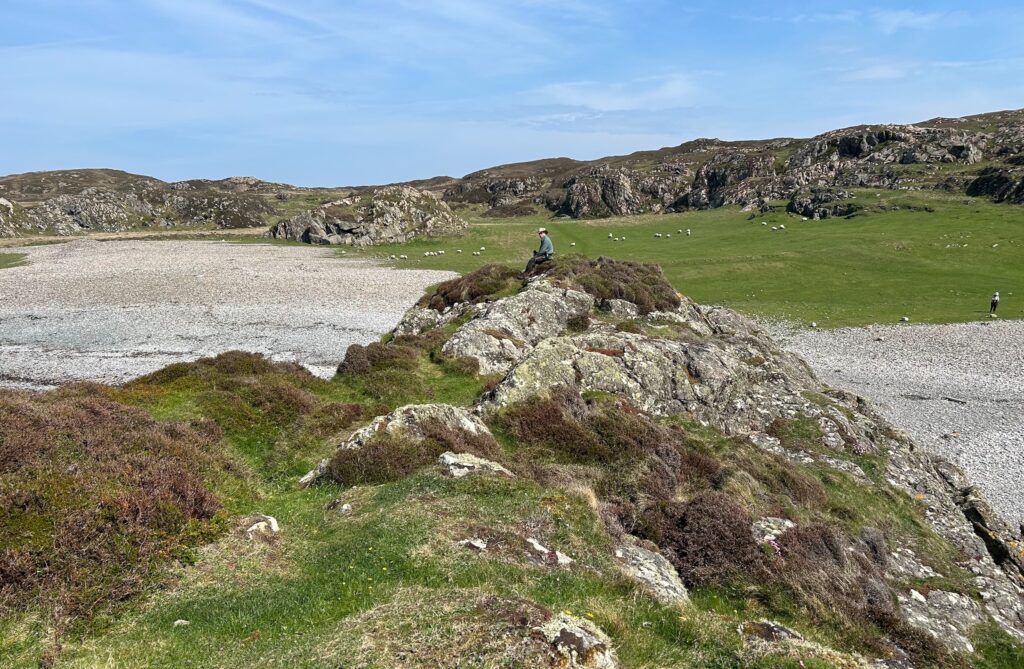
Colin (above) on the crag, looking inland; myself (below) taking photos
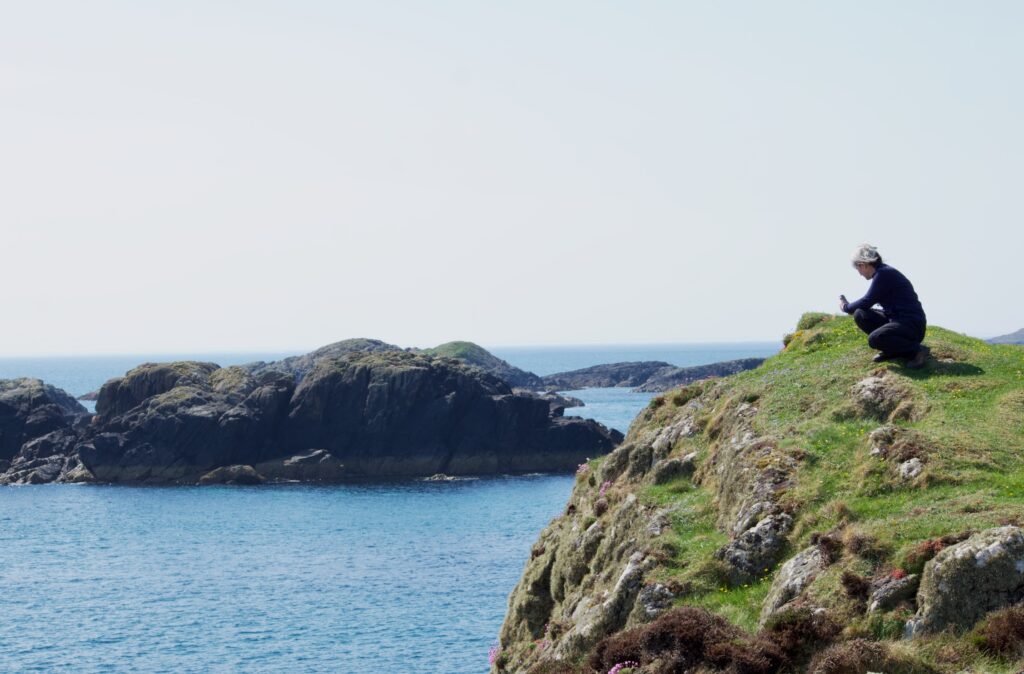

Early purple orchid
All beaches have to be left behind eventually, and we bent our steps inland again, stopping occasionally to look at wayside flowers and insects, or just to gaze at the view. The Bay at the Back of the Ocean trapped us again for a good hour or so and then we headed east, past the field where the corncrake was resting between performances, past Martyrs’ Bay and the nunnery, and on to the Abbey. Beyond that – just beneath the hill of Dun I – we thankfully put down our rucksacks, kicked off our boots, and cooked our dinner.
A tiring but beautiful day, one of those times when you sense that all the elements of nature and tide and weather are conspiring in your favour. We felt totally blessed. In the Sound of Iona, a tall ship was unfurling its sails. Far beyond, the cliffs of Mull rose out of a blue mist. Cuckoos were still calling long after sunset.
Photos copyright © Colin & Jo Woolf



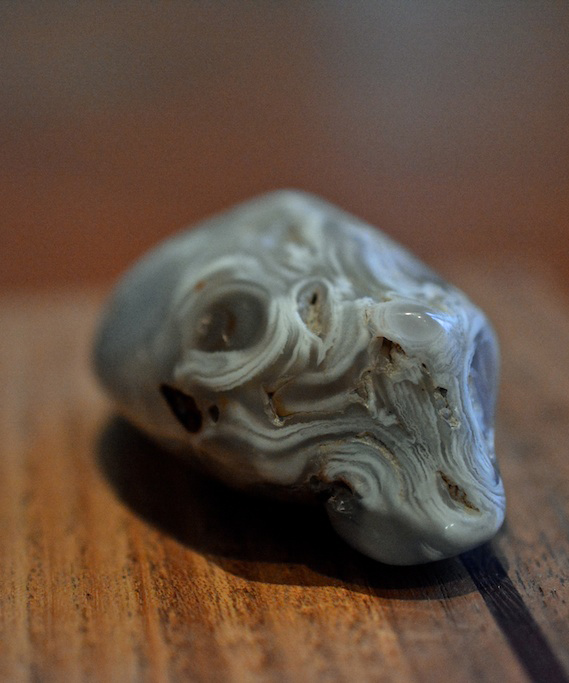
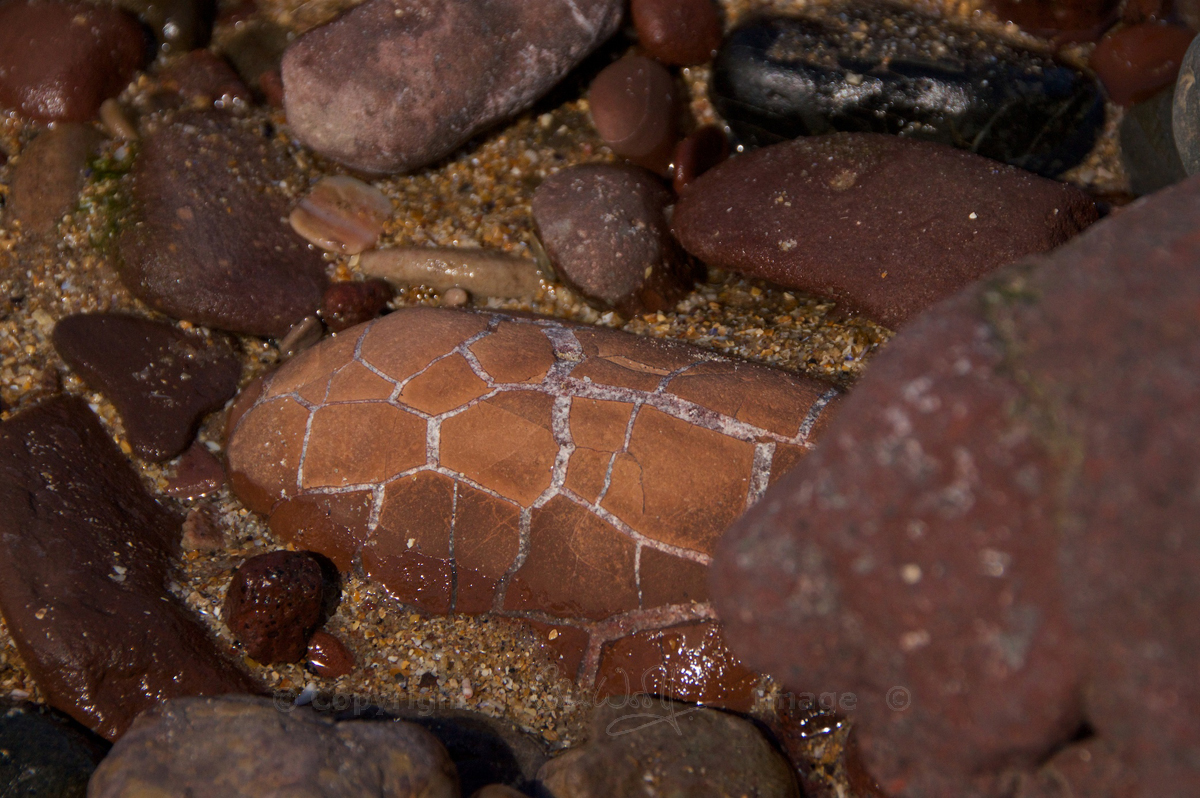
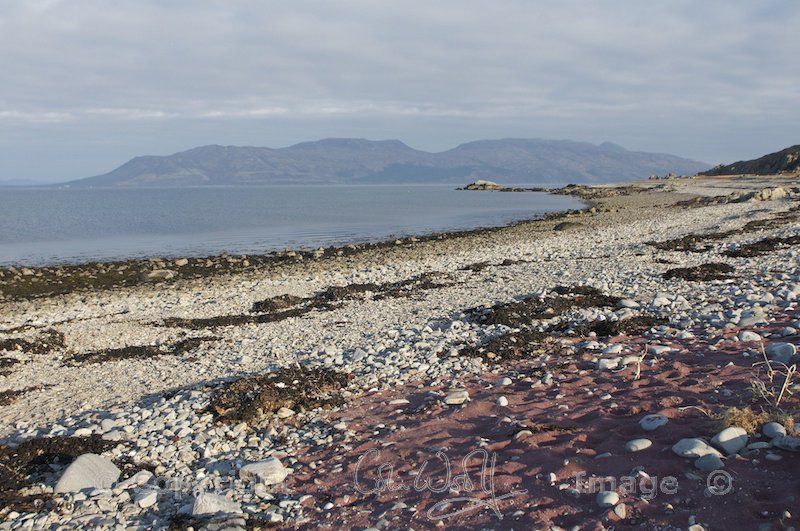
14 Comments
davidriggle
Lovely and thank you Jo. Have done that walk a good few times in all different weathers, but it’s always rewarding.
Jo Woolf
Thank you, David. It’s a walk we’d love to do again too. Already thinking about another visit, perhaps to look for different flowers that will be in season.
Deb Vallance
Your pictures and your prose are so inspiring. We can no longer travel or go on adventures so we do so vicariously, gratefully, with you. Thanks for this lovely post.
Jo Woolf
Thank you very much, Deb. I’m so glad to know you enjoy our adventures!
Bob Hay
Certainly a magic place Jo.You’d feel it penetrating into your bones. I hope you don’t mind me quoting here for your readers, the words of the great Dr Samuel Johnson when he visited Iona with Boswell.
(Makes my scalp tingle just reading it again).
“We were now treading that illustrious Island which was once the luminary of the Caledonian regions
whence savage clans and roaming barbarians derived the benefits of Knowledge and the blessings of
Religion. To abstract the mind from all local emotion would be impossible, if it were endeavoured,
and would be foolish if it were possible.
Whatever withdraws us from the power of our senses, whatever makes the past, the distant, or the future predominate over the present, advances us in the dignity of thinking beings. Far from me and from my friends be such frigid philosophy as may conduct us indifferent and unmoved over any ground which has been dignified by wisdom, bravery, or virtue.
That man is little to be envied whose patriotism would not gain force upon the plain of Marathon,
or whose piety would not grow warmer among the Ruins of lona”.
Jo Woolf
Thank you for posting that quote, Bob. Johnson was obviously moved by Iona’s special atmosphere, just as we are today. ‘Far from me and my friends..’ – very well said.
The Historian
Dear Colin and Jo Woolf,
Saint Columba (Collum Cille) was an indirect ancestor of mine. For that
reason, I\’m especially thrilled with your detailed \’walk to St Columba\’s
Bay\’.
Sincerely,
Catherine Murray,
Comrie,
PH6 2BA
Jo Woolf
Thank you, Catherine – I’m very glad you enjoyed the post.
Finola Finlay
Long-time ambition of mine to go to Iona – now made more urgent by your lovely post. There are cliffs on Cape Clear Island known as the Fir Bréagacha or the Lying Men. Westropp speculated that they got their name from seeming to be less dangerous than they actually were, when viewed from the sea.
Jo Woolf
I really hope you can come to Iona, Finola! You’d love it so much. That’s very interesting about the Cape Clear Island cliffs and the Lying Men. I hadn’t thought of that interpretation. I was thinking more along the lines of the outline of the cliffs or rocks suggesting a human figure or ‘false man’.
davidoakesimages
As you say… there are no words that can do justice to Iona beaches…or the joy of the island. Too many folk, understandably take the ferry trip and on landing head straight for the Abbey. But as you describe there is so much more. ( I do add that whilst other islands don’t have the historical links they also have such beautiful surroundings and of course those wonderful beaches…. but of course you know that 🙂 ).
Jo Woolf
Very true, David. And the Abbey would easily take up all of your time on a day trip.
Richard Miles
Dear Jo,
that’s an extremely interesting and well written post about a fascinating and very important place.
A long time ago the only aspect of religious studies I found interesting was when our teacher at school told us the fascinating story of St Columba leaving Ireland and settling on Iona. I have strong connections to Ireland and Scotland which explains the interest.
My Mum was from Argyll, and used to mention corncrakes when they used to be more plentiful. I know there have been great efforts by conservationists to protect these interesting birds in the West of Scotland.I think your photo of a goose is a grey lag which isn’t endangered.I’m ashamed to say I haven’t visited Iona yet, but I will for several reasons.
Richard Miles
Jo Woolf
Thank you so much for your kind words, Richard. You would love Iona. With your early interest in St Columba and your connections to Ireland and Argyll, I think the corncrakes will welcome you with a full chorus! I do hope that you can arrange a visit. You won’t ever regret it. All good wishes, Jo